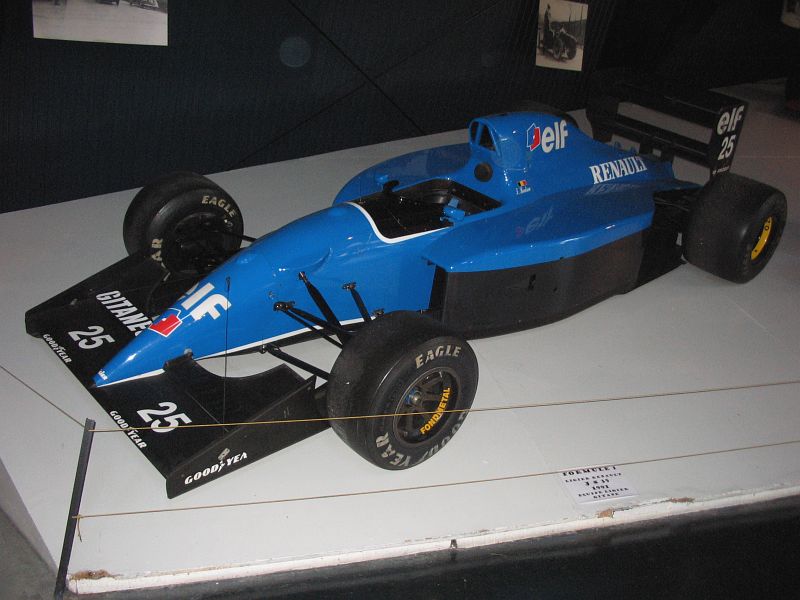Description
The Ligier Renault JS35 was the French team’s entry for the 1991 Formula One World Championship, a car that reflected both the ambition and the challenges faced by Ligier during one of its most turbulent eras. Designed during a period of transition, the JS35 carried the team’s hopes of returning to competitiveness but instead became emblematic of the difficulties that mid-level teams faced in adapting to the rapidly advancing technical landscape of early 1990s Formula One. Despite its elegant design and strong Renault V10 power, the JS35 struggled to find pace or reliability, making it a fascinating, if frustrating, chapter in Ligier’s long F1 history.
The JS35 was designed by Michel Beaujon and Claude Galopin under the technical direction of Michel Tétu, with input from long-time team principal Guy Ligier. It was built at the team’s base in Magny-Cours, France, which had recently become Ligier’s permanent home. The car’s chassis was a carbon-fibre and honeycomb monocoque—state-of-the-art for its time but relatively conventional in concept compared to the radical aerodynamic and suspension innovations being developed by the leading teams such as McLaren, Williams, and Ferrari.
At the heart of the JS35 was Renault’s RS1 3.5-litre naturally aspirated V10 engine, a 67-degree unit producing around 660 horsepower at 13,000 rpm. This engine was one of the most advanced in Formula One at the time, used with great success by Williams, but Ligier’s version lacked the latest specifications and the refined electronics of its factory counterparts. Power was transmitted through a six-speed transverse semi-automatic gearbox developed in-house by Ligier. While the Renault engine gave the car a promising foundation, integration and chassis tuning proved to be ongoing issues throughout the season.
Visually, the JS35 was one of the more handsome cars on the 1991 grid, with a clean, purposeful design and classic Ligier blue livery accentuated by Gitanes sponsorship. Aerodynamically, it featured a narrow, low nose with a sculpted front wing and deeply undercut sidepods feeding airflow to a large diffuser at the rear. The engine cover was tightly cowled, and the car’s overall shape reflected the aerodynamic priorities of the early 1990s—high downforce and reduced drag. However, despite its wind tunnel refinement, the JS35 suffered from poor balance, inconsistent grip, and a narrow performance window that made setup notoriously difficult.
The driver lineup for the 1991 season consisted of Thierry Boutsen and Érik Comas, both talented and experienced, with Boutsen having previously won races with Williams. Expectations were modest but hopeful, especially given the competitive potential of the Renault V10 engine. Unfortunately, the season began disastrously. The car proved unreliable and uncompetitive from the opening rounds, plagued by gearbox failures, handling instability, and a chronic lack of front-end grip. Boutsen failed to qualify at the season opener in Phoenix, a sobering indication of the car’s struggles.
Throughout the season, the team worked tirelessly to improve the JS35, introducing revisions to aerodynamics and suspension geometry. A revised model, the JS35B, was introduced mid-season with improved cooling and reworked aerodynamics, but the gains were marginal. The car remained heavy and difficult to drive, particularly in qualifying trim where outright pace was essential. Boutsen, frustrated by the car’s lack of response, publicly expressed his disappointment, while Comas, in his rookie year, managed to extract the best results possible, occasionally finishing in the lower midfield when reliability allowed.
The JS35’s best finish came at the Canadian Grand Prix, where Comas brought the car home in 10th place, while Boutsen managed 8th in Belgium, his home race. These modest results reflected the car’s limitations—it was reliable enough to finish races by mid-season but too slow to challenge for points in an era dominated by McLaren, Williams, and Ferrari. The Renault engine, while strong, could not compensate for deficiencies in chassis rigidity and aerodynamics.
The 1991 season was also significant for the internal politics surrounding Ligier. Guy Ligier’s influence was waning, and the team was in search of financial stability. The partnership with Renault was meant to provide technical continuity, but by the end of the year, Renault shifted its focus entirely to Williams, leaving Ligier to source alternative arrangements for the following season. The JS35 thus became the last Ligier car to run a Renault V10 until the partnership was revived years later under different circumstances.
By season’s end, Ligier had failed to score a single championship point, finishing near the bottom of the Constructors’ standings. The JS35 was quietly replaced by the JS37 for 1992, which featured a new Lamborghini V12 engine and a completely redesigned chassis. The lessons learned from the JS35’s shortcomings helped guide the team’s recovery later in the decade.
Despite its lack of success, the Ligier Renault JS35 occupies a unique place in Formula One history. It represented both the end of Ligier’s early Renault era and a period of reinvention for the French team. Its design embodied the tension between tradition and modernity—built with skill and ambition, but without the resources to compete at the sport’s highest technological level.
Today, the JS35 is remembered as a car of noble intent but flawed execution—a machine that carried the prestige of Ligier’s name and Renault’s engineering but could not bridge the gap between aspiration and achievement. In retrospect, it was part of the difficult transitional period that defined much of Formula One’s early 1990s landscape, when small independent teams struggled to keep pace with rapidly advancing technology.
The Ligier JS35 remains a symbol of persistence: a reminder that even in the shadow of the giants, teams like Ligier continued to embody the spirit of French motorsport—courageous, inventive, and unafraid to challenge the odds, even when success proved elusive.
